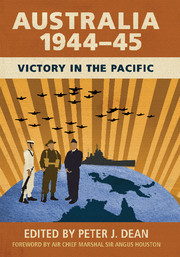Book contents
- Frontmatter
- Dedication
- Foreword
- Contents
- Maps and chart
- Figures and table
- Contributors
- Acknowledgements
- Abbreviations
- Military symbols on maps
- Introduction
- PART 1 STRATEGY
- PART 2 AUSTRALIA AT WAR
- PART 3 GREEN ARMOUR AND SPECIAL OPERATIONS
- PART 4 THE NAVAL AND AIR WAR
- 8 The RAN at War, 1944–45
- 9 ‘On the scrap heap of the Yanks’: The RAAF in the Southwest Pacific Area, 1944–45
- PART 5 THE NEW GUINEA CAMPAIGN
- PART 6 THE BORNEO CAMPAIGN
- Afterword: And Then Came Peace?
- Index
- References
9 - ‘On the scrap heap of the Yanks’: The RAAF in the Southwest Pacific Area, 1944–45
from PART 4 - THE NAVAL AND AIR WAR
Published online by Cambridge University Press: 05 December 2015
- Frontmatter
- Dedication
- Foreword
- Contents
- Maps and chart
- Figures and table
- Contributors
- Acknowledgements
- Abbreviations
- Military symbols on maps
- Introduction
- PART 1 STRATEGY
- PART 2 AUSTRALIA AT WAR
- PART 3 GREEN ARMOUR AND SPECIAL OPERATIONS
- PART 4 THE NAVAL AND AIR WAR
- 8 The RAN at War, 1944–45
- 9 ‘On the scrap heap of the Yanks’: The RAAF in the Southwest Pacific Area, 1944–45
- PART 5 THE NEW GUINEA CAMPAIGN
- PART 6 THE BORNEO CAMPAIGN
- Afterword: And Then Came Peace?
- Index
- References
Summary
Early in 1944, the Royal Australian Air Force (RAAF) was able to send out unprecedentedly large forces to bomb Japanese targets. This spoke well of the force's organisation and skill. Its aircrew and ground personnel were more experienced and able than ever before. The Allies’ strength made eventual victory certain, and Australia contributed to that victory. Yet the years 1944 and 1945 were in many respects deeply unsatisfying for the RAAF. A critical factor was Australia's relationship to the United States. The US Army Air Force (USAAF) had been growing much faster than the RAAF in the Southwest Pacific Area (SWPA): whereas in March 1943 the two forces had rough parity in squadrons, one year later the Americans had 82 squadrons to the RAAF's 45. The US squadrons boasted advanced types like the P-38 Lightning, while the Australian squadrons included obsolete types like the Vultee Vengeance dive-bomber, three squadrons of which the Americans banished from New Guinea in March 1944. This move and the sending of three Kittyhawk squadrons from New Guinea to New Britain represented the sidelining of No. 10 Operational Group, an Australian force established in September 1943 at the request of the Commander of Allied Air Forces, General Kenney, for operations in the forward areas of SWPA alongside the Fifth Air Force USAAF. No. 10 Operational Group was efficient and hard working. For example in February 1944, 78th Squadron racked up 1007 operational hours, as opposed to the 600 that was typical of RAAF fighter squadrons. That 600-hour figure was based on RAF standards, whereas General Whitehead demanded up to 1500 hours per month for his Fifth Air Force squadrons. Whitehead required the RAAF squadrons to increase their flying hours too, if they wanted a share of the confined airfield space in New Guinea. Group Captain Fred Scherger, the able and amenable commander of No. 10 Group, obliged. His force had been created to advance alongside the Americans. From March 1944 that was clearly most unlikely.
The Americans pointed to a silver lining on these dark clouds. The Vengeance crews were to be retrained to fly modern B-24 Liberator bombers, thus fulfilling a long-cherished Australian government and RAAF desire for four-engine heavy bomber squadrons of their own.
- Type
- Chapter
- Information
- Australia 1944–45Victory in the Pacific, pp. 190 - 208Publisher: Cambridge University PressPrint publication year: 2015



